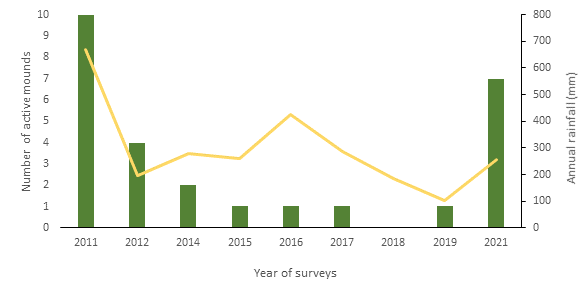Feral predator-free fences are proving effective at Mallee Cliffs National Park in western NSW where ecologists have recorded the highest number of active Malleefowl mounds in a decade!
AWC is excited to kickstart Biodiversity Month today by revealing that a total of 123 mounds were surveyed across the national park including 50 within the park’s 9,570-hectare feral predator-free fenced area established by AWC in August 2019 in partnership with NSW National Parks and Wildlife Service under the NSW Government’s Saving our Species program.
Malleefowl mound-nests are made of soil and buried wet leaf litter, constructed over a period of several months by both the male and female birds. Once the eggs are laid and covered the leaf litter begins to decompose and generate heat, acting as a natural incubator. The temperature is monitored and carefully maintained by the male adding or removing material within a narrow temperature range. Although the nests are often built in inconspicuous locations, they sit one metre in height, making them easy targets for ground-dwelling predators, particularly introduced foxes.
 NSW National Parks and Services
NSW National Parks and Services
During a survey in March this year, 123 Malleefowl mounds were surveyed inside and outside the fenced area. Of the mounds surveyed, seven were recorded as active – the highest number of active mounds recorded at Mallee Cliffs National Park since 2011.
Critically, breeding activity appears to be higher within the national park’s fenced area with five of the seven active mounds located inside the fence. A similar pattern of higher breeding activity within the fenced areas has also been observed at Scotia and Mt Gibson Wildlife Sanctuaries.
 W Lawler/AWC
W Lawler/AWC
AWC’s Senior Wildlife Ecologist, Dr. Laurence Berry, welcomed the increase in active Malleefowl mounds, saying it’s a positive step towards reversing the decline of the threatened bird that has been observed across its range.
“Malleefowl have had it tough in western NSW for a number of reasons including habitat loss and degradation, the impacts of feral herbivores as well as predation by feral animals such as cats and foxes,” Laurence explained.
“Recording a 10-year high in active mounds only 12 months after establishing a feral predator-free fenced area within Mallee Cliffs National Park is a great indication of the potential long-term value of these safe havens in protecting the future of Australia’s native species.”
The challenges facing Australia’s biodiversity are immense, but we’re scaling up our actions to protect threatened wildlife by continually improving our application of technology.
Please help us utilise conservation tech to save wildlife